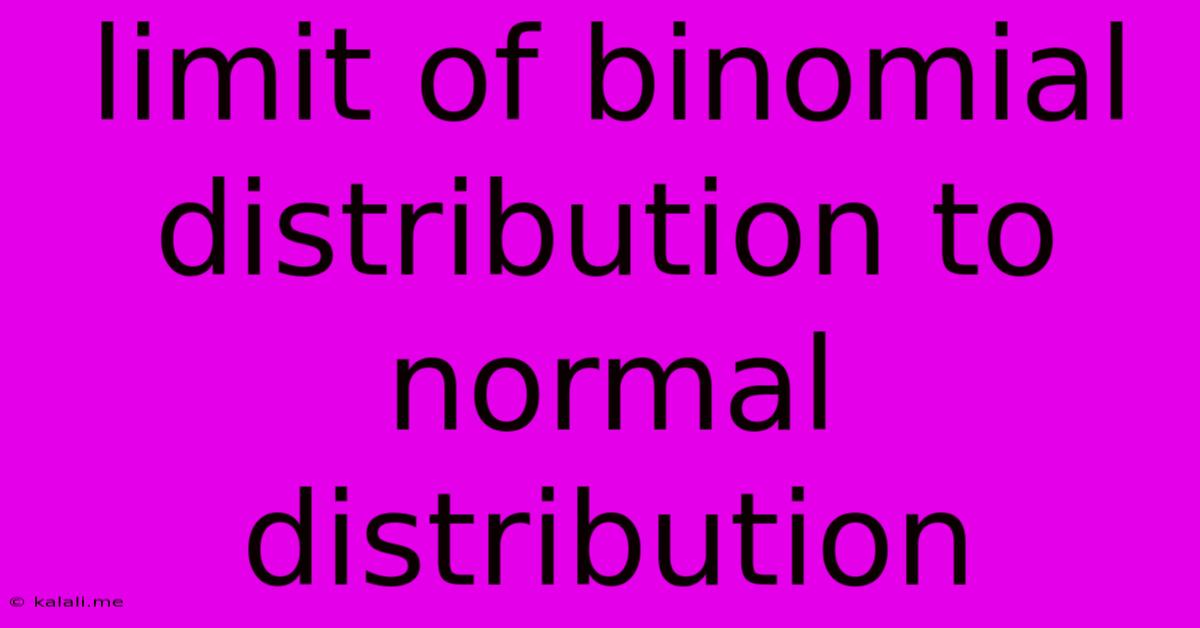Limit Of Binomial Distribution To Normal Distribution
Kalali
May 24, 2025 · 3 min read

Table of Contents
The Limit of the Binomial Distribution: Approximating with the Normal Distribution
The binomial distribution is a fundamental concept in probability and statistics, describing the probability of getting a certain number of successes in a fixed number of independent Bernoulli trials. However, calculating binomial probabilities can become computationally intensive for large numbers of trials. Fortunately, the central limit theorem provides a powerful solution: approximating the binomial distribution with the normal distribution. This article explores the conditions under which this approximation is valid and demonstrates its practical applications. Understanding this relationship is crucial for efficient statistical analysis.
The binomial distribution is defined by two parameters: n (the number of trials) and p (the probability of success in each trial). The probability of getting exactly k successes is given by the binomial probability formula: P(X=k) = (n choose k) * p^k * (1-p)^(n-k). As n increases, calculating these probabilities directly becomes increasingly complex.
When Can We Use the Normal Approximation?
The normal approximation to the binomial distribution is remarkably accurate when certain conditions are met. These conditions ensure that the shape of the binomial distribution closely resembles the bell curve of the normal distribution. The key criteria are:
-
Large n: The number of trials (n) should be sufficiently large. A common rule of thumb is that n should be at least 10.
-
Sufficiently large np and n(1-p): Both np (the expected number of successes) and n(1-p) (the expected number of failures) should be greater than or equal to 5 (or sometimes 10, depending on the desired level of accuracy). This ensures that the distribution isn't severely skewed.
If these conditions are satisfied, we can approximate the binomial distribution with a normal distribution having the same mean (μ = np) and standard deviation (σ = √(np(1-p))).
Performing the Normal Approximation
Once the conditions are met, the approximation involves standardizing the binomial variable using the z-score formula:
Z = (X - μ) / σ = (X - np) / √(np(1-p))
Where:
- X is the number of successes
- μ = np is the mean
- σ = √(np(1-p)) is the standard deviation
This standardized z-score can then be used with a standard normal distribution table (or calculator) to find probabilities. Remember to apply the continuity correction for improved accuracy. This involves adjusting the value of X by ±0.5 before calculating the z-score, to account for the discrete nature of the binomial distribution and the continuous nature of the normal distribution.
Example: Approximating Binomial Probabilities
Let's say we have a coin flipped 100 times (n = 100), and we want to find the probability of getting 60 or more heads, assuming a fair coin (p = 0.5). Since np = 50 and n(1-p) = 50, both are greater than 5, the normal approximation is appropriate.
- Calculate the mean: μ = np = 100 * 0.5 = 50
- Calculate the standard deviation: σ = √(np(1-p)) = √(100 * 0.5 * 0.5) = 5
- Apply the continuity correction: We want P(X ≥ 60), so we use X = 59.5.
- Calculate the z-score: Z = (59.5 - 50) / 5 = 1.9
- Find the probability: Using a z-table, P(Z ≥ 1.9) ≈ 0.0287
Conclusion: A Powerful Tool for Approximation
The normal approximation to the binomial distribution is a valuable tool for simplifying calculations when dealing with a large number of trials. By understanding the conditions for its application and employing the continuity correction, we can accurately estimate binomial probabilities, saving significant computational effort while maintaining a high degree of precision. This approximation is widely used in various fields, including quality control, polling, and hypothesis testing, demonstrating its practical importance in statistical analysis.
Latest Posts
Latest Posts
-
Hash Of Data Does Not Match Digest In Descriptor
May 24, 2025
-
How To Tell If Avocado Is Bad
May 24, 2025
-
F 14 Fighter Jet For Sale
May 24, 2025
-
Do Christians Believe In The Virgin Mary
May 24, 2025
-
Mtg Play Card When You Search
May 24, 2025
Related Post
Thank you for visiting our website which covers about Limit Of Binomial Distribution To Normal Distribution . We hope the information provided has been useful to you. Feel free to contact us if you have any questions or need further assistance. See you next time and don't miss to bookmark.